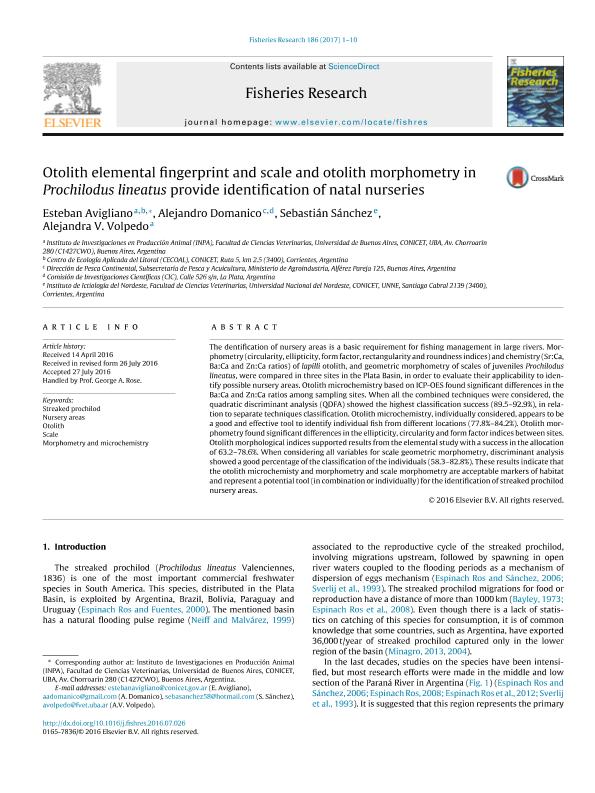Mostrar el registro sencillo del ítem
dc.contributor.author
Avigliano, Esteban

dc.contributor.author
Domanico, Alejandro
dc.contributor.author
Sánchez, Sebastián
dc.contributor.author
Volpedo, Alejandra

dc.date.available
2018-09-12T14:50:11Z
dc.date.issued
2017-02
dc.identifier.citation
Avigliano, Esteban; Domanico, Alejandro; Sánchez, Sebastián; Volpedo, Alejandra; Otolith elemental fingerprint and scale and otolith morphometry in Prochilodus lineatus provide identification of natal nurseries; Elsevier Science; Fisheries Research; 186; Part 1; 2-2017; 1-10
dc.identifier.issn
0165-7836
dc.identifier.uri
http://hdl.handle.net/11336/59278
dc.description.abstract
The dentification of nursery areas is a basic requirement for fishing management in large rivers. Morphometry (circularity, ellipticity, form factor, rectangularity and roundness indices) and chemistry (Sr:Ca, Ba:Ca and Zn:Ca ratios) of lapilli otolith, and geometric morphometry of scales of juveniles Prochilodus lineatus, were compared in three sites in the Plata Basin, in order to evaluate their applicability to identify possible nursery areas. Otolith microchemistry based on ICP-OES found significant differences in the Ba:Ca and Zn:Ca ratios among sampling sites. When all the combined techniques were considered, the quadratic discriminant analysis (QDFA) showed the highest classification success (89.5–92.9%), in relation to separate techniques classification. Otolith microchemistry, individually considered, appears to be a good and effective tool to identify individual fish from different locations (77.8%–84.2%). Otolith morphometry found significant differences in the ellipticity, circularity and form factor indices between sites. Otolith morphological indices supported results from the elemental study with a success in the allocation of 63.2–78.6%. When considering all variables for scale geometric morphometry, discriminant analysis showed a good percentage of the classification of the individuals (58.3–82.8%). These results indicate that the otolith microchemisty and morphometry and scale morphometry are acceptable markers of habitat and represent a potential tool (in combination or individually) for the identification of streaked prochilod nursery areas.
dc.format
application/pdf
dc.language.iso
eng
dc.publisher
Elsevier Science

dc.rights
info:eu-repo/semantics/openAccess
dc.rights.uri
https://creativecommons.org/licenses/by-nc-nd/2.5/ar/
dc.subject
Morphometry And Microchemistry
dc.subject
Nursery Areas
dc.subject
Otolith
dc.subject
Scale
dc.subject
Streaked Prochilod
dc.subject.classification
Agricultura

dc.subject.classification
Agricultura, Silvicultura y Pesca

dc.subject.classification
CIENCIAS AGRÍCOLAS

dc.title
Otolith elemental fingerprint and scale and otolith morphometry in Prochilodus lineatus provide identification of natal nurseries
dc.type
info:eu-repo/semantics/article
dc.type
info:ar-repo/semantics/artículo
dc.type
info:eu-repo/semantics/publishedVersion
dc.date.updated
2018-09-11T14:45:43Z
dc.journal.volume
186
dc.journal.number
Part 1
dc.journal.pagination
1-10
dc.journal.pais
Países Bajos

dc.journal.ciudad
Amsterdam
dc.description.fil
Fil: Avigliano, Esteban. Consejo Nacional de Investigaciones Científicas y Técnicas. Centro Científico Tecnológico Conicet - Nordeste. Centro de Ecología Aplicada del Litoral. Universidad Nacional del Nordeste. Centro de Ecología Aplicada del Litoral; Argentina. Consejo Nacional de Investigaciones Científicas y Técnicas. Oficina de Coordinación Administrativa Parque Centenario. Unidad Ejecutora de Investigaciones en Producción Animal. Universidad de Buenos Aires. Facultad de Ciencias Veterinarias. Unidad Ejecutora de Investigaciones en Producción Animal; Argentina
dc.description.fil
Fil: Domanico, Alejandro. Ministerio de Agroindustria. Dirección de Pesca Continental. Subsecretaría de Pesca y Acuicultura; Argentina. Provincia de Buenos Aires. Gobernación. Comisión de Investigaciones Científicas; Argentina
dc.description.fil
Fil: Sánchez, Sebastián. Universidad Nacional del Nordeste. Facultad de Ciencias Veterinarias. Instituto de Ictiología del Nordeste; Argentina
dc.description.fil
Fil: Volpedo, Alejandra. Consejo Nacional de Investigaciones Científicas y Técnicas. Oficina de Coordinación Administrativa Parque Centenario. Unidad Ejecutora de Investigaciones en Producción Animal. Universidad de Buenos Aires. Facultad de Ciencias Veterinarias. Unidad Ejecutora de Investigaciones en Producción Animal; Argentina
dc.journal.title
Fisheries Research

dc.relation.alternativeid
info:eu-repo/semantics/altIdentifier/doi/http://dx.doi.org/10.1016/j.fishres.2016.07.026
dc.relation.alternativeid
info:eu-repo/semantics/altIdentifier/url/https://www.sciencedirect.com/science/article/pii/S0165783616302387
Archivos asociados
